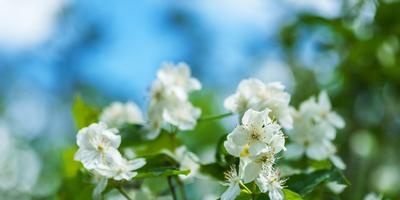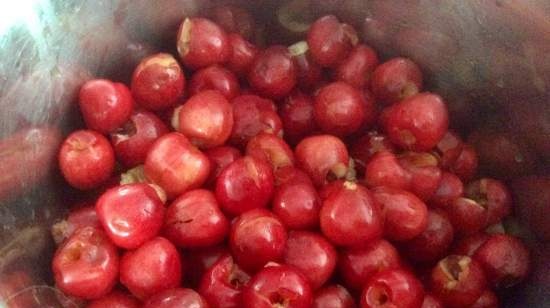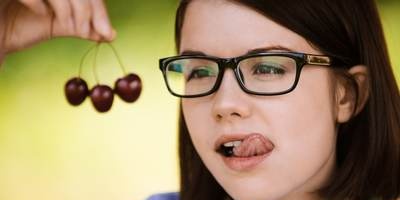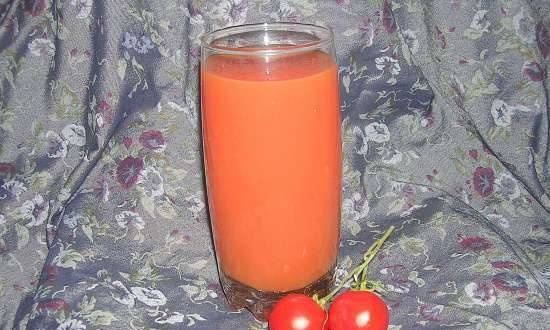|
 A resident of the city of Khvalynsk G. Cherebaev set himself the task of ruining the cherry orchard. He bought a cherry orchard. The previous owner cut down some of the trees before the sale so that the site had a well-kept look. A resident of the city of Khvalynsk G. Cherebaev set himself the task of ruining the cherry orchard. He bought a cherry orchard. The previous owner cut down some of the trees before the sale so that the site had a well-kept look.
After the felling, overgrowth began, but it was so thick that you couldn't get through. Only hares could squeeze between the trunks. They found excellent shelter in the garden, and from there they raided the neighboring gardens.
Cherebaev tried to thin out the bushes, but incurred even more trouble. The undergrowth grew denser, and the number of scythes increased accordingly. For three years the Khvalyn fought against the undergrowth with a pick and an ax, until he brought the garden into proper shape.
The Siberian gardener M. Nikiforov from the Blagodatny farm on the Yenisei reacted differently to the cherry invasion. He got hold of the seeds of the Ural steppe cherry and sowed it in the nursery. Prepared the most splendid land. Kept her in a black pair so that not a single blade of grass would penetrate. He started with all kinds of fertilizers, poured lime and ash. I applied the same square-nesting method of planting, which the world thought of after half a century.
 Alas, all his troubles ended sadly. The trees grew amicably and quickly, but instead of bearing fruit, they sprouted dense growth from the roots, causing the legitimate indignation of the owner, who was tired of the constant struggle with his pets. If he endured the onslaught of cherries, it was only because they perfectly tolerated the Siberian frosts. Alas, all his troubles ended sadly. The trees grew amicably and quickly, but instead of bearing fruit, they sprouted dense growth from the roots, causing the legitimate indignation of the owner, who was tired of the constant struggle with his pets. If he endured the onslaught of cherries, it was only because they perfectly tolerated the Siberian frosts.
Finally Nikiforov gave up. He gave up tending the cherry orchard.
Come what may. Apparently not destiny.
And as soon as he stopped weeding and loosening the soil, as now the black steam was overgrown with herbs, and now it seemed that this was not an exemplary nursery garden, but an ordinary Ural steppe with a wild cherry tree. And then this is what happened. As if sensing freedom, the cherry blossom bloomed and gave its first fruits. On some bushes there were so many of them that the branches were bent. It was just that the steppe cherry needed to return to its natural setting. Nikiforov selected the best bushes, removed the fruits from them and sowed them. And the offspring became even better, more luxurious.
The overgrowth, however, does not always bring unnecessary trouble. If you are well versed in the life of cherries, you can turn it to your advantage. In the 16th century in Vladimir, the local patriarch laid a cherry orchard. Years, centuries passed, the cherry orchard regularly produced a wonderful harvest of black and red fruits, although the life of a cherry tree is short. In total, twenty-five or thirty years, and with poor care, half that. In a hundred years, trees should have died four times, and they live! The trunks, of course, dried up after serving their due date. But to replace them, fresh shoots rose from the roots. She became new trunks. The Patriarchal Garden has not thinned out over the years.
Since then, the people of Vladimir have been so carried away by the unpretentious tree that it has become the most common, peasant one. They even bred their own variety - Vladimirskaya cherry. Throughout Central Russia, there is now no more delicious Vladimir cherry. It contains a moderate amount of acid and slightly less sugar than beets. It is remarkable that the sweetness is preserved wherever it is grown: in hot Tashkent or cold Leningrad.
The only flaw, it seems, is too much temptation for birds. However, this also applies to all cherries in general. History has preserved an interesting fact on this matter. The Prussian king Frederick the Great was a big cherry hunter. But in his gardens sparrows ruled and took some of the harvest. Frederick could not tolerate such arbitrariness. He declared war on the birds. Soon the unfortunate creatures were killed. However, the victory was Pyrrhic. She did not bring joy to the king, but unnecessary trouble, because two years later the cherries disappeared from the orchards altogether, and with them the fruits of apples, pears and plums. Instead, the gardens were filled with fat caterpillars formerly controlled by birds. Realizing his mistake, the king, who prided himself on his invincibility, was forced to go to peace with the sparrows.
 But back to our Russian cherries. In 1892, Professor N. Kichunov announced to the whole country that a new variety had appeared in the Kursk province - Lyubskaya cherry. The magazines immediately began to print many articles about the new variety. The opinions were very opposite. But back to our Russian cherries. In 1892, Professor N. Kichunov announced to the whole country that a new variety had appeared in the Kursk province - Lyubskaya cherry. The magazines immediately began to print many articles about the new variety. The opinions were very opposite.
Supporters of the Kursk novelty praised Lyubskaya to the skies. Opponents scolded. Kursk patriots tried to convince: look, its fruits are twice as large as those of Vladimirskaya. And harvests - every year. Critics from Kharkov were ironic: who needs a harvest when you can't take it in your mouth! Sour like lemon! Do not eat a handful - it will tear your mouth apart! And they called her Razderi-Roth!
Kharkiv citizens recommended their sweet cherry Shpanka. The dispute was settled by M. Balabanov, an expert in fruit business. At first he seemed to be scolding Lyubskaya too.
- Lyubskaya reminds me of the quality of the Kurskaya Sklyanka apple tree. In its raw form, its fruits are completely unsuitable for eating. I would recommend planting it where neighbors are stealing fruit. Lyubskaya as a dessert, of course, is also bad. But what kind of jam is it! What compotes and marinades! Spanking is no good for her - freshness!
And Balabanov made a practical conclusion. If you plant a spank, then very little. Closer to the cities. To feast on in the summer. Lyubskaya advised to breed in any scale. For blanks - an unrivaled grade. There will never be a loss.
Our famous gardener I. Michurin was also a staunch supporter of Lyubov cherry. He also bred several good varieties himself. But his cherished goal was to create Cerapadus - a hybrid of cherry and bird cherry (cherry - cerazus, bird cherry - padus). The planned new variety should have fruits that are large and tasty, like those of cherries, and hang in clusters as abundant as those of a bird cherry. He took the Ideal cherry and crossed it with Maak's Far Eastern bird cherry. The trunk of Maak's bird cherry, unlike ours, Central Russian, is as if cast from bronze. Golden chocolate, shiny. The berries in the clusters are smaller than those of the common bird cherry and are bitter. People do not eat them - only bears, climbing a tree and laying branches under their backs, as they do with an apple tree in the Caucasus.
No sooner said than done. The fruits of the Cerapadus were, as planned, the size of a cherry and hung in tassels like a bird cherry. But the bitterness came from the Far Eastern parent. There was no fruit. What would our glorious gardener do next? He probably had his own thoughts on this matter. Or maybe there was a plan for further action? How to bring a cherry-bird cherry semi-finished product to condition? Alas, we do not know this. Michurin died. And Cerapadus remained a kind of botanical curiosity.
Years passed. The audience forgot about the Cerapadus. However, scientists from Michurinsk continued his work. Shortly before Michurin's death, a young graduate of the Kalinin Pedagogical Institute S. Zhukov received a new hybrid, Padocerus. But in 1941 Zhukov died at the front. His son, O. Zhukov, took over the baton in our days. And on time. A dangerous pest of cherry orchards - coccomycosis - has emerged on the horizon. Microscopic mushroom. It was discovered in the 50s in the western regions of the country. In diseased trees, foliage falls off in June, and the fruits turn out to be unusable. They are not filmed. In winter, weakened creatures freeze slightly (here, as luck would have it, winters have become severe). The next summer they are uprooted and sawed for firewood.
Meanwhile, the mushroom was advancing rapidly. In the mid-60s, he captured the Baltic states, Belarus and Ukraine. Has done a lot of trouble in the central regions.
 Of the 500 varieties that we grow, not one is immune from adversity. The most annoying thing is that the same Lyubskaya cherry, which was so praised by Balabanov and Michurin, got the most. In 1974, the mushroom was destroyed by Razderi-Rot in many state farms in the Tambov, Oryol and neighboring regions. The gardens had to be used for firewood. The Vladimir cherry held on more steadfastly, but she also gave up when the enemy's onslaught became unbearable. Of the 500 varieties that we grow, not one is immune from adversity. The most annoying thing is that the same Lyubskaya cherry, which was so praised by Balabanov and Michurin, got the most. In 1974, the mushroom was destroyed by Razderi-Rot in many state farms in the Tambov, Oryol and neighboring regions. The gardens had to be used for firewood. The Vladimir cherry held on more steadfastly, but she also gave up when the enemy's onslaught became unbearable.
At this difficult hour, O. Zhukov with a team of biologists examined ailing gardens in the Tambov region. They created the Cherry program. Against the backdrop of bare, without foliage, plantings of Lyubskaya and Vladimirskaya cherries, green islands with new varieties have clearly emerged. These are Pamyat Vavilov and three more varieties created in Michurinsk, at the breeding station.But even these islets were caught here and there by a mushroom. Only Cerapadus and Padocerus were not affected at all. That's when Michurin's dream came in handy. The Cherry program is counting on them. True, they still carry with them bitterness. It was not possible to overcome it immediately.
And now about one more cherry - about sakura. Sakura from Japan. In Japan, the climate is maritime and humid. Cherries there, if they bear fruit, then they are watery and tasteless. They are not usually eaten. But in spring, at the time of cherry blossoms, crowds of people admire for hours as if enchanted by the white or pink clouds of its air crowns. The Soviet writer and diplomat N. Fedorenko believes that nowhere in the world is there such a nationwide cult of cherry flowers as in Japan. People, tired after a hard day, go out into nature to admire the sakura. "Flowers-trees" in spring are covered with simple and double tassels of pink, cream and yellow color.
Sakura is planted in the streets, it is painted, branches are put in vases in houses, poetry is written about it. Just don't eat.
A. Smirnov. Tops and roots
Read now
All recipes
|
 A resident of the city of Khvalynsk G. Cherebaev set himself the task of ruining the cherry orchard. He bought a cherry orchard. The previous owner cut down some of the trees before the sale so that the site had a well-kept look.
A resident of the city of Khvalynsk G. Cherebaev set himself the task of ruining the cherry orchard. He bought a cherry orchard. The previous owner cut down some of the trees before the sale so that the site had a well-kept look. Alas, all his troubles ended sadly. The trees grew amicably and quickly, but instead of bearing fruit, they sprouted dense growth from the roots, causing the legitimate indignation of the owner, who was tired of the constant struggle with his pets. If he endured the onslaught of cherries, it was only because they perfectly tolerated the Siberian frosts.
Alas, all his troubles ended sadly. The trees grew amicably and quickly, but instead of bearing fruit, they sprouted dense growth from the roots, causing the legitimate indignation of the owner, who was tired of the constant struggle with his pets. If he endured the onslaught of cherries, it was only because they perfectly tolerated the Siberian frosts. But back to our Russian cherries. In 1892, Professor N. Kichunov announced to the whole country that a new variety had appeared in the Kursk province - Lyubskaya cherry. The magazines immediately began to print many articles about the new variety. The opinions were very opposite.
But back to our Russian cherries. In 1892, Professor N. Kichunov announced to the whole country that a new variety had appeared in the Kursk province - Lyubskaya cherry. The magazines immediately began to print many articles about the new variety. The opinions were very opposite. Of the 500 varieties that we grow, not one is immune from adversity. The most annoying thing is that the same Lyubskaya cherry, which was so praised by Balabanov and Michurin, got the most. In 1974, the mushroom was destroyed by Razderi-Rot in many state farms in the Tambov, Oryol and neighboring regions. The gardens had to be used for firewood. The Vladimir cherry held on more steadfastly, but she also gave up when the enemy's onslaught became unbearable.
Of the 500 varieties that we grow, not one is immune from adversity. The most annoying thing is that the same Lyubskaya cherry, which was so praised by Balabanov and Michurin, got the most. In 1974, the mushroom was destroyed by Razderi-Rot in many state farms in the Tambov, Oryol and neighboring regions. The gardens had to be used for firewood. The Vladimir cherry held on more steadfastly, but she also gave up when the enemy's onslaught became unbearable.




























































































































































































